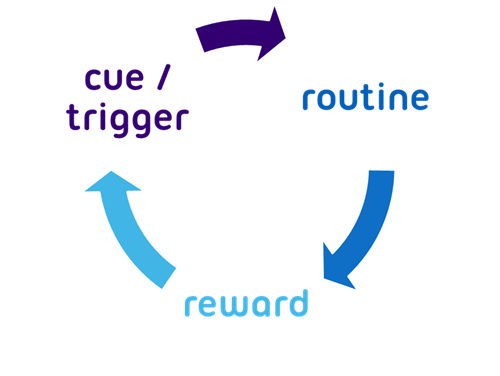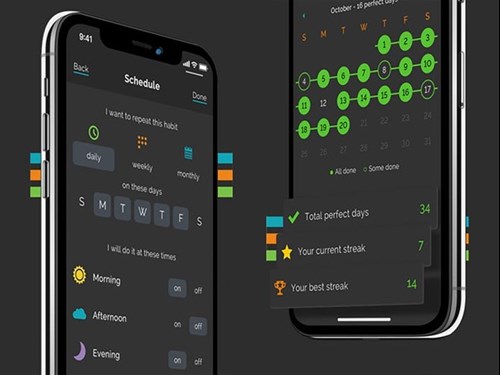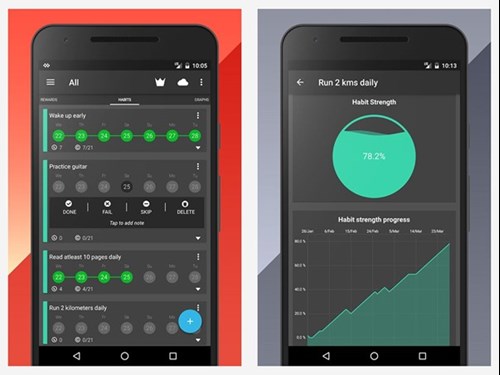Become a habit changer
Forming new habits can be challenging, and there are lots of myths out there. Understand how habits work and how to change them.
Forming new habits can be challenging, and there are lots of myths out there.
The biggest myth is this - bad habits are because of a lack of willpower.
Let today be the day you give up who you’ve been for who you can become.
You can easily end up blaming yourself if you try to break a habit and don't succeed. But the reality is that habits are automatic processes. In fact, research shows that from the moment you wake up to the second you fall asleep, nearly half of what you do is automatic. You're not even aware of making a decision.
Yet whenever you want to change something about yourself, you rely on your willpower. You hope that being determined will be enough.
But what if you could harness the amazing power of your non-conscious mind to reach your goals? To do this you need to understand how habits work. Whether you want to improve your fitness, eat better, form better sleep patterns or strengthen relationships, all habits follow the same psychological pattern: the “habit loop”.
The Habit Loop
Most habits are formed of a loop - a cue or trigger, a behaviour routine, and a reward. The cue acts as a signal, which triggers an automatic routine that leads to a reward. Whenever you receive the cue, your brain instantly remembers the reward and restarts the routine.

Understanding this, and then making changes, gives you the power to change the outcome.
Keys to Changing Habits
So you want to change a habit?
The first key is to decide that you actually want to change and that you’re ready to do so. There’s no point in starting on the journey if you’re not sure whether you want to change. All you’ll do is frustrate yourself.
But assuming you’re ready to make a change, the next step is to decide what habit you want to change. It helps to write this down somewhere – this helps you agree with yourself that this is an issue you want to tackle.
Now that you’ve decided what habit you want to tackle, it’s important to spend some time understanding the problem.
You’ll need to understand and spend some time looking at each of the three parts of the habit loop. There aren’t any quick short cuts here if you want to make lasting change happen. So if you want real change to happen, find a bit of uninterrupted time to think this through.
Identify the Cue / Trigger
What’s triggering the habit? Nearly all cues can be grouped into one of five categories:
- Time. When does the habit happen? Is it linked to a particular time of day?
- Location. Where does the habit happen? In your kitchen? At work?
- Who’s around? Are there particular people that seem to trigger the behaviour?
- A previous action that just happened. For example, you switch off the news on TV, go into the kitchen and reach for a biscuit or you wake up, put the alarm on snooze and roll over.
- Your emotional state. Does getting angry or feeling lonely make you reach for the chocolate?
You may find that it’s a combination of these things that creates the trigger e.g. you feel tired at home mid-morning and grab a biscuit to give yourself a bit of an energy boost. The time is mid-morning, the location is your kitchen at home and your emotional state is that you’re feeling tired.
Identify the Reward
Usually, it’s quite easy to figure out what the reward is. It’ll be the cheese in the fridge, the biscuit in the cupboard, the sweets in the box, the extra time in bed in the morning.
But understanding the craving behind it is more challenging, and requires a bit of experimenting to understand what the real motivation is.
Let’s look at the biscuit example. You'll need to understand why you head for the kitchen cupboard. Is it really hunger? Why is your energy low? Have you just worked solidly for 3 hours? Do you feel tired? Is it that you feel a bit lonely?
In order to understand what will satisfy the craving as well as the biscuit, you’ll need to experiment. You’ll need to test out some alternative rewards. For example, you might want to try out the following things over a few days:
- Try taking a 5-minute break and going for a quick walk around the block. It’s likely that you’ll feel more rested as a result and your productivity will improve.
- Try drinking some water instead. This will stretch your stomach, reducing hunger pangs, and rehydrate you.
- Try calling or messaging a friend and having a quick chat. This would help reduce any loneliness that you’re feeling and may improve your energy.
Try going through this process, trying out different options, until you find one that seems to work.
Change the routine
Now you know the cue and the reward, you can start changing the routine.
A simple way of doing this is to use if-then phrases. For example, "If I feel tired at work at 4pm, then I will get up and walk about for 5 minutes because it relaxes me."
It really helps to write these statements down and put them somewhere obvious.
We’ve put together a habit changer tool to help you with this process. To get started now, download it, print it off then stick it somewhere obvious like your fridge or cupboard door, or beside your desk.
Download the habit changer tool
Watch this great video now to understand how to form habits that stick and why understanding your behaviour triggers is so important.
8 Helpful Tips to Changing Habits
Here are 8 helpful tips to get you on your way:
- Work on one habit at a time. It's important to work on only one new habit at a time. That way your store of willpower can be channelled into completing that one thing, increasing your chances of success.
- Commit for at least a month. The length of time varies from person to person and how difficult the habit is. Some habits take at least 10 weeks to form.
- Link your new habit to an existing one. E.g. "When I get up, I'll change into some active gear and exercise for 10 minutes."
- Take baby steps and start slow. Create a commitment so small it's impossible to fail. It's more important to do something every day than it is to hit a milestone.
- Make a plan for obstacles. Prepare and anticipate that obstacles will come. That way you won't be blindsided.
- Create accountability. Tell some trusted people about your new habit. You're more likely to follow through that way.
- Reward yourself when you reach a milestone. It's really important to celebrate the successful completion of your goals.
- Build a new identity. It's better to decide that the new habit is simply a part of the new you. Each small win then demonstrates who you are on the inside.
Keystone Habits
Keystone habits are powerful habits that can help make changes stick. Watch this video now and learn some of the secrets of successful habit formation.
Apps to Help You Get Started
There are a number of free apps to help you get going. Highest rated ones include:
- Productive (iOS only). Productive is a free and easy-to-use tool that helps you build a routine of positive, life-changing habits. Set personal goals, track your progress, and motivate yourself to new heights!
Productive can help you with planning your schedule to create healthy new habits. Setting smart reminders for throughout your day and analysing your daily, weekly and monthly progress are just a couple of the ways that Productive keeps you on track.

- HabitHub (Android only). HabitHub lets you set daily reminders and provides graphs that help you stay motivated along your journey. On top of this, every morning when you wake up, HabitHub sends you a nice little motivational quote. With HabitHub your task is to build a long streak of days for the habit you are working on.

- Google Fit and Apple Health. Google and Apple's own fitness tracking apps: Apple Health comes built into iOS, and Google Fit usually comes with Android (if it isn't on your phone, download it here). They'll count steps using your phone sensors, and can accept a host of other data from other apps too.
Importantly, both built-in apps have goal-setting and reminder features that can make sure you're doing enough walking or running in the day, or that you're not sitting down for long stretches, and so on. If you've got a smartwatch, these apps work on your wrist too.




